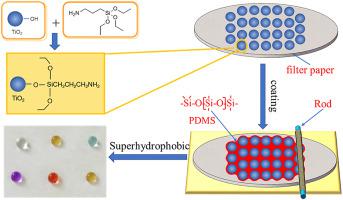当前位置:
X-MOL 学术
›
Polym. Test.
›
论文详情
Our official English website, www.x-mol.net, welcomes your
feedback! (Note: you will need to create a separate account there.)
Robust superhydrophobic surface fabrication by fluorine-free method on filter paper for oil/water separation
Polymer Testing ( IF 5.0 ) Pub Date : 2020-11-01 , DOI: 10.1016/j.polymertesting.2020.106810 Yuhong Teng , Yufeng Wang , Baoying Shi , Xinyue Li , Yunzhi Chen
Polymer Testing ( IF 5.0 ) Pub Date : 2020-11-01 , DOI: 10.1016/j.polymertesting.2020.106810 Yuhong Teng , Yufeng Wang , Baoying Shi , Xinyue Li , Yunzhi Chen

|
Abstract Robust superhydrophobic surface exhibiting anti-fouling and self-cleaning ability were successfully fabricated by nano TiO2 modified by γ-aminopropyltriethoxysilane (KH550) and polydimethylsiloxane (PDMS) via wire rod coating. Due to the lower surface energy of PDMS and the hierarchical structure caused by the different aggregation sizes of TiO2 nanoparticles, the contact angle of the resulting superhydrophobic coating was 154.5° and the rolling angle was 3.5°. And the coated paper still had good non-wettability under water immersion. In addition, the coated paper was tolerant to mechanical damage and various temperature conditions. Even after 40 sandpaper wear cycles, the coating can still maintain good mechanical stability and superhydrophobicity. The superhydrophobic paper was used for oil-water separation, the separation efficiency was about 98% even after used 10 times. Furthermore, the prepared superhydrophobic paper exhibited excellent self-cleaning and anti-fouling properties, as well as demonstrated superb resistance to various water solutions owing to its high hydrophobicity. Moreover, the prepared superhydrophobic paper has application prospects in the industry of special wetting materials.
中文翻译:

通过无氟法在滤纸上制备坚固的超疏水表面用于油/水分离
摘要 采用γ-氨基丙基三乙氧基硅烷(KH550)和聚二甲基硅氧烷(PDMS)改性纳米TiO2,通过线棒涂层成功制备了具有抗污和自清洁能力的坚固超疏水表面。由于PDMS较低的表面能和TiO2纳米颗粒不同聚集尺寸引起的分级结构,所得超疏水涂层的接触角为154.5°,滚动角为3.5°。并且铜版纸在水浸下仍具有良好的不润湿性。此外,涂层纸可耐受机械损伤和各种温度条件。即使经过 40 次砂纸磨损循环,涂层仍能保持良好的机械稳定性和超疏水性。超疏水纸用于油水分离,即使使用10次,分离效率也达到98%左右。此外,制备的超疏水纸表现出优异的自清洁和防污性能,并且由于其高疏水性而表现出对各种水溶液的优异耐受性。此外,所制备的超疏水纸在特殊润湿材料行业具有应用前景。
更新日期:2020-11-01
中文翻译:

通过无氟法在滤纸上制备坚固的超疏水表面用于油/水分离
摘要 采用γ-氨基丙基三乙氧基硅烷(KH550)和聚二甲基硅氧烷(PDMS)改性纳米TiO2,通过线棒涂层成功制备了具有抗污和自清洁能力的坚固超疏水表面。由于PDMS较低的表面能和TiO2纳米颗粒不同聚集尺寸引起的分级结构,所得超疏水涂层的接触角为154.5°,滚动角为3.5°。并且铜版纸在水浸下仍具有良好的不润湿性。此外,涂层纸可耐受机械损伤和各种温度条件。即使经过 40 次砂纸磨损循环,涂层仍能保持良好的机械稳定性和超疏水性。超疏水纸用于油水分离,即使使用10次,分离效率也达到98%左右。此外,制备的超疏水纸表现出优异的自清洁和防污性能,并且由于其高疏水性而表现出对各种水溶液的优异耐受性。此外,所制备的超疏水纸在特殊润湿材料行业具有应用前景。











































 京公网安备 11010802027423号
京公网安备 11010802027423号